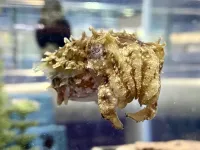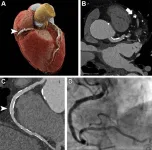(Press-News.org) Back in the 1920s, researchers discovered that cancer patients had sweet-smelling urine. First, the doctors were puzzled, but they soon realised that it was a result of elevated blood sugar levels.
“This was one of the first things we learned about cancer patients,” says Associate Professor Lykke Sylow.
The sweet-smelling urine suggested that cancer affects the body’s blood sugar level. But how? A new study is ready to answer that question. Where previous studies have examined the connection between cancer and insulin, Lykke Sylow and colleagues’ new study is the first to compile the best research on the topic, and the answer seems to be clear:
“In cancer patients, the cells do not respond well to the hormone insulin. It therefore takes more insulin to create the same effect in cancer patients. If you suffer from insulin resistance, your body has to produce more insulin than usual to be able to regulate the blood sugar,” says Lykke Sylow, who is one of the main authors of the new study.
About the study
The researchers conducted a meta-analysis of 15 studies of insulin sensitivity and cancer. This included 187 patients suffering from different types of cancer, including lung and colon cancer, and 154 control subjects.
They only included studies applying the so-called gold standard, which is a very precise way of analysing insulin sensitivity in humans.
And the body’s ability to respond to insulin is impaired in both cancer patients and people with type 2 diabetes.
Symptoms of type 2 diabetes such as fatigue and increased thirst and urination develop gradually and can therefore be hard to spot. And in cancer patients, insulin resistance can be even harder to identify as they already experience some of these symptoms, e.g. fatigue.
Insulin can cause cancer cells to multiply
Aside from the negative consequences of insulin resistance, the condition can also cause cancer cells to multiply.
“We know from cell studies, animal studies and some human studies that insulin is a growth hormone, and that it has the same effect on cancer cells. That is, a high level of insulin can make cancer cells grow faster,” says the second main author of the study, Joan Màrmol, and adds:
“Of course, this can be a huge problem for cancer patients.”
Furthermore, insulin resistance can influence the build-up of proteins in the muscles. That is, if the body fails to respond to insulin, it will lose muscle mass and strength, and that is a huge problem for a lot of cancer patients.
All in all, cancer and insulin resistance is a really bad combination.
Lykke Sylow hopes oncologists will begin to check patients’ blood sugar level – even when it appears to be normal, because insulin resistance can be hard to spot as the body will simply compensate by producing more insulin.
“And if they do find that the patient suffers from insulin resistance, they need to start treating it. We are able to treat insulin resistance because we have in-depth knowledge of the condition – we are just used to associating it with type 2 diabetes.”
Aspects of the connection require more research, though.
“The next step is trying to determine who develops insulin resistance. Which cancer patients are at risk here? Do they have a particular type of cancer or specific risk factors? Or is it perhaps connected with the treatment?” Lykke Sylow says and adds:
“And once we have identified those at high risk of developing the condition, I hope to see more long-term studies of insulin resistance treatment and whether it has a positive effect on the patients.”
You can read the full study, “Insulin resistance in patients with cancer: a systematic review and meta-analysis”, in Acta Oncologica.
END
Hidden mechanism connects cancer and diabetes
Insulin resistance is usually associated with type 2 diabetes. Now researchers have found it in cancer patients and learned that it can cause cancer to spread faster.
2023-06-20
ELSE PRESS RELEASES FROM THIS DATE:
The meaning behind the Woodstock character in ‘Peanuts’
2023-06-20
COLUMBUS, Ohio – Charles Schulz, creator of the comic strip “Peanuts,” was anything but a hippie.
Still, he named the beloved yellow bird character in “Peanuts” Woodstock after the famous counterculture music festival that was attended and celebrated by the younger generation who grew up in the 1960s and ’70s, including many who saw themselves as hippies.
The question is why, says Michelle Ann Abate, author of the new book Blockheads, Beagles, and Sweet Babboos: New Perspectives on Charles M. Schulz’s Peanuts.
Based on her critical analysis of the strips featuring Woodstock, ...
Restoring the blood-brain barrier?
2023-06-20
There's a bouncer in everyone: The blood-brain barrier, a layer of cells between blood vessels and the rest of the brain, kicks out toxins, pathogens and other undesirables that can sabotage the brain's precious gray matter.
When the bouncer is off its guard and a rowdy element gains entry, a variety of conditions can crop up. Barrier-invading cancer cells can develop into tumors, and multiple sclerosis can occur when too many white blood cells slip pass the barrier, leading to an autoimmune attack on the protective layer of brain nerves, hindering their communication with the rest of the body.
"A leaky blood-brain barrier is a common ...
Combining cancer-targeting virus therapy with radiation to fight brain cancer works better than either treatment on its own: study
2023-06-20
EDMONTON — Combining a cancer-targeting virus with radiation to treat brain cancer in mice was more effective than either therapy on its own according to University of Alberta research, providing hope for new treatments that combine immunotherapy with traditional surgery, chemotherapy or radiation.
The researchers treated mice with glioblastoma brain tumours simultaneously with high-dose radiation and a genetically engineered oncolytic vaccinia virus, a virus that has been used safely as a vaccine against smallpox.
The ...
Exploring the deep connections between adolescent sleep and overall health
2023-06-20
As director of SRI’s Human Sleep Research Program, Fiona Baker studies the complex interplay between sleep and overall health and well-being.
Much of her work has been focused on sleep patterns in adult women, but recently her attention has turned to adolescents. Adolescence is a crucial time for developing healthy sleep patterns as it is for brain development. In her research, Baker draws clear lines of connection between the two.
“Sleep is so important to us all, but especially for teenagers or adolescents,” Baker says. “Between the ages of 10 and 21, or so, and even a little later, the ...
SRI seeks to learn how insects speak through smells
2023-06-20
All around us, insects are speaking to each other: jockeying for mates, searching for food, and trying to avoid becoming someone else’s next meal. Some of this communication is easy to spot—like the flashes of fireflies on a summer night or a screaming chorus of cicadas in the afternoon—but many of the most sophisticated conversations are challenging to observe, occurring through an exchange of chemical scents.
Understanding chemical communication could be the key to finding new, more effective ways to protect crops or ward off biting insects that can transmit diseases. Researchers ...
Cuttlefish brain atlas first of its kind
2023-06-20
NEW YORK, NY — Anything with three hearts, blue blood and skin that can change colors like a display in Times Square is likely to turn heads. Meet Sepia bandensis, known more descriptively as the camouflaging dwarf cuttlefish. Over the past three years, a team led by neuroscientists at Columbia’s Zuckerman that includes data experts and web designers has put together a brain atlas of this captivating cephalopod: a neuroanatomical roadmap depicting for the first time the brain’s overall 32-lobed structure as well its cellular organization.
The ...
Climate action plans mobilize limited urban change, researchers report
2023-06-20
The Intergovernmental Panel on Climate Change Fifth Assessment Report (AR5), released just prior to an international climate convention in 2015, explicitly stated that human-caused greenhouse gas emissions were the highest in history, with clear and widespread impacts on the climate system. Since then, hundreds of cities across the world have published their own climate action plans (CAPs), detailing how their urban areas will handle climate change. How do the plans stack up against one another and against the recommended ...
Photon-counting CT noninvasively detects heart disease in high-risk patients
2023-06-20
OAK BROOK, Ill. – New ultra-high-resolution CT technology enables excellent image quality and accurate diagnosis of coronary artery disease in high-risk patients, a potentially significant benefit for people previously ineligible for noninvasive screening, according to a study published in Radiology, a journal of the Radiological Society of North America (RSNA).
Coronary artery disease is the most common form of heart disease. Coronary CT angiography (CCTA) is highly effective for ruling out coronary artery disease ...
Self-driving revolution hampered by a lack of accurate simulations of human behavior
2023-06-20
Self-driving revolution hampered by a lack of accurate simulations of human behaviour
Algorithms that accurately reflect the behaviour of road users - vital for the safe roll out of driverless vehicles - are still not available, warn scientists.
They say there is “formidable complexity” in developing software that can predict the way people behave and interact on the roads, be they pedestrians, motorists or bike riders.
To improve the modelling, a research team led by Professor Gustav Markkula from the Institute of Transport Studies ...
Toxic emissions from wildland-urban interface fires
2023-06-20
Fires in the wildland-urban interface (WUI) emit more toxic smoke than wildfires burning in natural vegetation, due to the chemicals in the structures, vehicles, and other manufactured goods that burn in fires in areas of human habitation. Amara Holder and colleagues surveyed the literature on emissions from urban fuels, finding 28 experimental studies that reported emission factors—emissions per unit of fuel burned—for various items, such as home furnishings, consumer electronics, and vehicle ...
LAST 30 PRESS RELEASES:
Injectable breast ‘implant’ offers alternative to traditional surgeries
Neuroscientists devise formulas to measure multilingualism
New prostate cancer trial seeks to reduce toxicity without sacrificing efficacy
Geometry shapes life
A CRISPR screen reveals many previously unrecognized genes required for brain development and a new neurodevelopmental disorder
Hot flush treatment has anti-breast cancer activity, study finds
Securing AI systems against growing cybersecurity threats
Longest observation of an active solar region
Why nail-biting, procrastination and other self-sabotaging behaviors are rooted in survival instincts
Regional variations in mechanical properties of porcine leptomeninges
Artificial empathy in therapy and healthcare: advancements in interpersonal interaction technologies
Why some brains switch gears more efficiently than others
UVA’s Jundong Li wins ICDM’S 2025 Tao Li Award for data mining, machine learning
UVA’s low-power, high-performance computer power player Mircea Stan earns National Academy of Inventors fellowship
Not playing by the rules: USU researcher explores filamentous algae dynamics in rivers
Do our body clocks influence our risk of dementia?
Anthropologists offer new evidence of bipedalism in long-debated fossil discovery
Safer receipt paper from wood
Dosage-sensitive genes suggest no whole-genome duplications in ancestral angiosperm
First ancient human herpesvirus genomes document their deep history with humans
Why Some Bacteria Survive Antibiotics and How to Stop Them - New study reveals that bacteria can survive antibiotic treatment through two fundamentally different “shutdown modes”
UCLA study links scar healing to dangerous placenta condition
CHANGE-seq-BE finds off-target changes in the genome from base editors
The Journal of Nuclear Medicine Ahead-of-Print Tip Sheet: January 2, 2026
Delayed or absent first dose of measles, mumps, and rubella vaccination
Trends in US preterm birth rates by household income and race and ethnicity
Study identifies potential biomarker linked to progression and brain inflammation in multiple sclerosis
Many mothers in Norway do not show up for postnatal check-ups
Researchers want to find out why quick clay is so unstable
Superradiant spins show teamwork at the quantum scale
[Press-News.org] Hidden mechanism connects cancer and diabetesInsulin resistance is usually associated with type 2 diabetes. Now researchers have found it in cancer patients and learned that it can cause cancer to spread faster.



